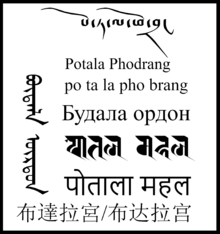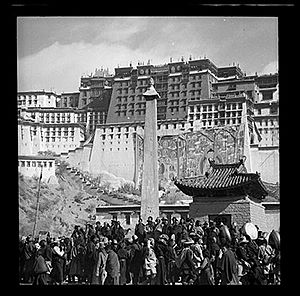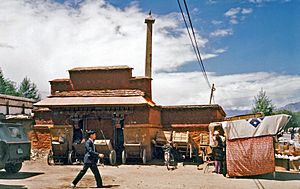Potala Palace facts for kids
The Potala Palace is a huge, castle-like building in Lhasa, Tibet, China. For many years, it was the winter home of the Dalai Lamas, who are important spiritual leaders. This was from 1649 to 1959.
Today, the Potala Palace is a museum. It became a World Heritage Site in 1994. This means it is a very special place recognized by UNESCO for its cultural importance.
The palace gets its name from Mount Potalaka. This is a mythical mountain believed to be the home of Avalokiteśvara. He is a very important figure in Buddhism.
The 5th Dalai Lama started building the palace in 1645. His adviser, Konchog Chophel, thought the spot was perfect. It was located between two important monasteries, Drepung and Sera, and the old city of Lhasa. Some people believe an older fortress, built by Songtsen Gampo in 637, might have been on this same spot.
The Potala Palace is very large. It is about 400 meters (1,300 feet) long from east to west. It is also 350 meters (1,150 feet) wide from north to south. Its stone walls are very thick, about 3 meters (10 feet) on average. At the bottom, they are even thicker, about 5 meters (16 feet). Copper was poured into the foundations to help protect it from earthquakes.
The palace has thirteen floors. It contains over 1,000 rooms, 10,000 shrines, and about 200,000 statues. It stands 117 meters (384 feet) tall on top of a hill called Marpo Ri, or "Red Hill." This hill rises more than 300 meters (980 feet) above the valley floor.
People in Tibet believe that the three main hills of Lhasa are like "Three Protectors of Tibet." Chokpori, south of the Potala, represents Vajrapani. Pongwari represents Manjusri. Marpori, where the Potala stands, represents Avalokiteśvara.
Contents
A Look at Its Past
Quick facts for kids Potala Palace |
|||||
|---|---|---|---|---|---|

"Potala Palace" in different languages.
|
|||||
| Tibetan name | |||||
| Tibetan | པོ་ཏ་ལ་ཕོ་བྲང | ||||
|
|||||
| Mongolian name | |||||
| Mongolian script | ᠪᠦᠲᠠᠯᠠ ᠥᠷᠳᠥᠨ | ||||
The Potala Palace was built on the site of an older palace. This older palace was built by Songtsen Gampo on the Red Hill. Inside the Potala, there are two chapels that still have parts of the original building. One is the Phakpa Lhakhang. The other is the Chogyel Drupuk, which is believed to be Songtsen Gampo's meditation cave.
Lozang Gyatso, also known as the Great Fifth Dalai Lama, began building the modern Potala Palace in 1645. His spiritual adviser, Konchog Chophel, suggested the spot. It was a great place for a government seat. It was located between the Drepung and Sera monasteries and the old city of Lhasa.
The outside of the palace was built in just three years. But the inside, with all its decorations and furniture, took 45 years to finish. The Dalai Lama and his government moved into the White Palace (Potrang Karpo) in 1649. The building work continued until 1694, even after the Dalai Lama had passed away.
From then on, the Potala was used as the Dalai Lama's winter home. The Red Palace (Potrang Marpo) was added between 1690 and 1694.
The palace got its name from a hill in India. This hill was sacred to Avalokitesvara, who is also known as Chenrezi. Tibetans often call the palace "Peak Potala" or simply "the Peak."
Protecting a World Treasure
The Potala Palace was slightly damaged during the 1959 Tibetan uprising. Some shells hit the palace windows. However, it was saved from major damage during the Cultural Revolution in 1966. This was thanks to Zhou Enlai, who was then the leader of China.
The palace was added to the UNESCO World Heritage List in 1994. Later, in 2000 and 2001, the Jokhang Temple and Norbulingka were also added. These are other important sites in Lhasa.
UNESCO has been concerned about new buildings around the palace. These modern buildings could change the palace's special atmosphere. In response, the Chinese government made a rule. No new buildings taller than 21 meters (69 feet) can be built in the area.
UNESCO was also worried about the materials used for restoring the palace. Restoration work began in 2002. However, the palace's director said that only traditional materials and methods were used. The palace also had restoration work done between 1989 and 1994.
To protect the palace, the number of visitors is limited. From May 1, 2003, only 1,600 visitors were allowed each day. Opening hours were also reduced. Before this, the palace sometimes had over 5,000 visitors in one day.
The visitor limit was increased to 2,300 daily after the Qingzang railway opened in 2006. This train brought more visitors to Lhasa. During busy times, like July to September, opening hours were extended. Even then, the daily limit was often reached quickly. Visits to the roof were stopped in 2006 to prevent more damage.
Palace Design
The Potala Palace is built at a high altitude of 3,700 meters (12,100 feet). It sits on the side of Ri Marpo, or 'Red Mountain', in the center of Lhasa Valley. Its huge walls slope inwards. The upper parts have many rows of windows. It also has flat roofs at different levels. This makes it look a lot like a strong fortress.
At the bottom of the rock, on the south side, there is a large area. It is surrounded by walls and gates. Inside, there are big entrance halls. Easy staircases lead up to the top of the rock. The entire top of the rock is covered by the palace.
The central part of the palace is very tall. It rises above the other buildings. It has golden roofs, similar to those on the Jokhang temple. This central part is called the "red palace." It gets its name from its crimson color. This color makes it stand out from the rest of the palace.
The Red Palace holds the main halls, chapels, and shrines of past Dalai Lamas. Inside, you can see rich decorative paintings. There is also jeweled work, carvings, and other beautiful decorations.
On the south side, the lower white part of the palace was used for a special event. During the Sertreng Festival, two giant thangkas were hung there. These are large religious paintings. They showed the figures of Tara and Sakyamuni.
The Putuo Zongcheng Temple in China was partly designed like the Potala Palace. It is also a UNESCO World Heritage Site. The Potala Palace was even named one of the "New Seven Wonders" by an American TV show and newspaper.
The nine-story Leh Palace in India was built earlier. It was a building that looked similar to the Potala Palace.
The Lhasa Zhol Pillars
In Lhasa Zhol Village, there are two old stone pillars. They are called rdo-rings. One is the doring nangma, which is inside the village walls. The other is the doring chima. This one used to stand outside the south entrance of the village. Today, it is located east of Liberation Square.
The doring chima pillar is very old. It dates back to around 764 AD. It has what might be the oldest known example of Tibetan writing.
The pillar has messages honoring a famous Tibetan general. It tells about his services to the king. This includes battles against China. These battles led to the capture of the Chinese capital, Chang'an (now Xian), in 763. During this time, the Tibetans briefly put a relative of Princess Jincheng Gongzhu on the throne. She was the Chinese wife of Trisong Detsen's father.
Images for kids
See also
 In Spanish: Potala para niños
In Spanish: Potala para niños
- Norbulingka, the Dalai Lama's former summer palace
- Jokhang Temple Monastery
- Leh Palace
- Mount Putuo
- List of tallest structures built before the 20th century










